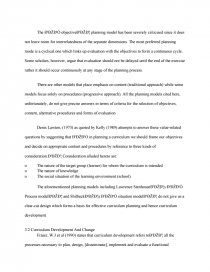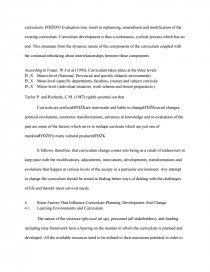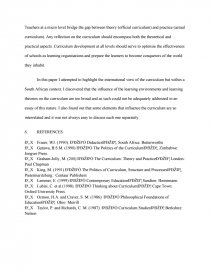Curriculum Development and Change
Essay by review • December 24, 2010 • Research Paper • 2,368 Words (10 Pages) • 2,051 Views
INTRODUCTION
There seems to be a lot of controversy and uncertainty as to Ð'ÐŽÐ'Òwhat is the curriculum?Ð'ÐŽÐ'¦ As such, there is a distributing lack of consensus on an all-embracing definition of this comprehensive concept. This is, in part, due to the various interpretations, meanings, emphasis and approaches that the scholars of curriculum studies embark upon. This, in turn, leaves the education practitioners and the general public in the dark as to what constitutes that which should be considered as Ð'ÐŽÐ'Ògood curriculum practiceÐ'ÐŽÐ'¦ in educational institutions.
This exposition seeks to highlight and evaluate the key concepts of the curriculum and some of the factors that have marked influence on curriculum planning, curriculum development and change. The impact that learning environments, learning theories, culture, ideologies and knowledge have on the curriculum will be briefly brought to the fore.
2. KEY CONCEPTS OF THE CURRICULUM
The term curriculum is derived from a Latin word Ð'ÐŽÐ'ÒcurereÐ'ÐŽÐ'¦ meaning the Ð'ÐŽÐ'ÒracecourseÐ'ÐŽÐ'¦. Implicit in the meaning is, as cited by Fraser, W.J. et al (1990:81). The fact that the curriculum is Ð'ÐŽÐ'Òa relatively fixed track or terrain (learning content) which must be covered (mastered) by the participant (learner) in order to reach the winning-post (learning result).Ð'ÐŽÐ'¦
Based on this literal meaning, attempts to clarify what the curriculum is have led to the following definitions:
Ð'„X A programme of study
Ð'„X Course content
Ð'„X Planned learning experiences
Ð'„X Intended learning outcomes
Ð'„X A plan for instruction
According to Graham-Jolly, M. (2000:3), these definitions are narrow interpretations of the curriculum since
Ð'ÐŽKthe term is often used to refer to the formal academic programme provided by a school, as reflected in subjects on the timetable,,,it might also be used to refer to a particular course of instruction or syllabus.
The focus here is, in the main, on didactic activities as they occur within the classroom situation.
The latest trend, however, places emphasis on a broader and more inclusive interpretation of the concept, which takes into cognisance the social, political, economic and historical contexts within which the curriculum is designed, developed and implemented.
Lubisi, C et al (1998) distinguishes between the curriculum as a Ð'ÐŽÐ'ÒproductÐ'ÐŽÐ'¦ or Ð'ÐŽÐ'ÒplanÐ'ÐŽÐ'¦ (narrow perspective) and curriculum as Ð'ÐŽÐ'ÒpracticeÐ'ÐŽÐ'¦ or Ð'ÐŽÐ'ÒprocessÐ'ÐŽÐ'¦ (broad perspective). The product view entails a plan to be followed by the teachers (blue print) in carrying out the didactic activities. The practice view encompasses all the activities that inform the occurrences in an educational institution.
In a nutshell, the narrow perspective pays more attention on the intentions, plans or ideas regarding what should happen in a school. On the contrary, the broad perspective focuses on the existing state of affairs and recognises the actual happenings based on social constructs.
2.1 DIFFERENT FORMS OF CURRICULUM
Lengthy debates pertaining to the definition of the curriculum, among curriculists, have culminated in the emergence of divergent connotations and hence various forms of the curriculum namely:
2.1.1. Formal or Ð'ÐŽÐ'ÒofficialÐ'ÐŽÐ'¦ curriculum
A planned and documented form of the curriculum.
2.1.2. Ð'ÐŽÐ'ÒActualÐ'ÐŽÐ'¦ curriculum
- That which takes place when the Ð'ÐŽÐ'ÒofficialÐ'ÐŽÐ'¦ curriculum is implemented.
2.1.3. Ð'ÐŽÐ'ÒHiddenÐ'ÐŽÐ'¦ curriculum
The values, beliefs and norms of behaviour that are communicated implicitly through the process of socialisation; intentionally or unintentionally. The hidden curriculum is accidental in nature and is a by-product of planned activities. Social and sex roles are acquired through this form of the curriculum.
2.1.4 Ð'ÐŽÐ'ÒCommonÐ'ÐŽÐ'¦ curriculum
This form of the curriculum seeks to address the imbalances and inequities that existed in racially-divided South African educational institution.
In the light of the vast complexity of dimensions pertaining to the word curriculum, I find it proper not to commit myself by trying to define this comprehensive term. I am, however, of the opinion that in any definition of the curriculum attempts should be made somehow to include the Ð'ÐŽÐ'ÒhiddenÐ'ÐŽÐ'¦ curriculum, a broad perspective that is:
3. Curriculum Planning, Development and Change
3.1 Curriculum Planning
Professor Ralph Tyler notes with concern that curriculum planning consists of four dimensions namely objectives or goal, content or subject matter, method or procedures and evaluation. This is a very simple and linear model which starts off by specifying what we intend to achieve (objectives). Next the ground to be covered (content) is considered followed by the mechanisms to be put in place in reaching the goals envisage (methods) and finally, make attempts to measure the success of the whole exercise (evaluation).
The Ð'ÐŽÐ'ÒobjectiveÐ'ÐŽÐ'¦ planning model has been severely criticised since it does not leave room for interrelatedness of the separate dimensions. The most preferred planning mode is a cyclical one which links up evaluation with the objectives to form a continuous cycle. Some scholars, however, argue that evaluation should not be delayed until the end of the exercise rather it should occur continuously at any stage of the planning process.
There are other models that place emphasis
...
...









